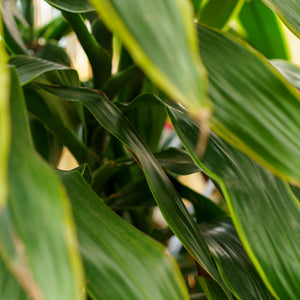The Dracaena Guide
Dracaena is a popular genus of houseplants admired for their architectural form, striking foliage, and low-maintenance needs. With tall upright growth, glossy leaves in a variety of green and variegated shades, and an ability to thrive in low light, Dracaena has become a staple in homes and offices alike. Whether you’re drawn to the bold, spiky look of Dracaena marginata or the lush, striped foliage of Dracaena 'Lemon Surprise', these tropical beauties offer style and resilience in equal measure.
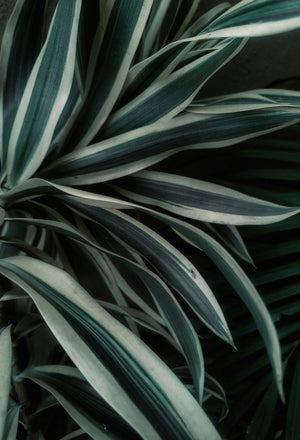
About
The Dracaena genus contains approximately 120 species, most of which are native to Africa, southern Asia, and northern Australia. These plants belong to the Asparagaceae family and are classified as monocots due to their leaf venation and fibrous root systems. The name “Dracaena” is derived from the Greek word drakaina, meaning “female dragon,” a nod to the red resin some species produce, historically referred to as “dragon’s blood.”
Popular cultivars include Dracaena 'Cintho', known for its bold, upright canes and broad green leaves; Dracaena 'Lemon Surprise', with vibrant chartreuse margins; and Dracaena 'Rikki', a tough, adaptable variety with long striped foliage. Dracaena marginata, or Madagascar dragon tree, is one of the most common varieties, with thin, spiky leaves and a narrow, upright growth habit ideal for tight spaces. Other notable varieties include 'Costaricana', 'Pele', 'Michiko', and 'Tornado', each offering unique variations in color, shape, and texture.
Dracaenas are commonly grouped with “corn plants,” such as Dracaena fragrans, due to their thick canes and arching foliage that resembles corn leaves. While typically grown as houseplants, some varieties can thrive outdoors in tropical or subtropical climates.
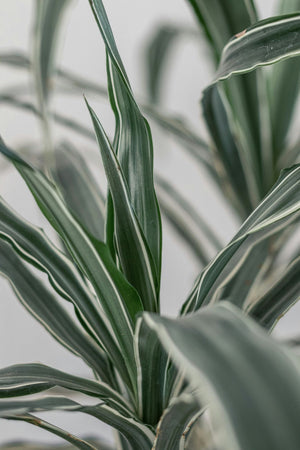
PLANTING
Dracaena is typically grown in containers indoors, where it thrives with minimal effort. To ensure healthy establishment and long-term success, follow these planting tips:
- USDA Hardiness Zones: Best grown indoors in most climates, but can survive outdoors in Zones 10–12.
- Soil: Use a well-draining potting mix, preferably one formulated for indoor tropical plants. A mix with peat, perlite, and pine bark is ideal.
- Container: Choose pots with drainage holes to prevent root rot. Avoid overly large containers that retain excess moisture.
- Light: Bright, indirect light is ideal. Dracaena tolerates lower light conditions but will grow more slowly and with less vivid coloring.
- Planting Time: Can be planted or repotted any time of year when grown indoors. Best done in spring or early summer for outdoor growth.
When transplanting, gently loosen the roots and position the plant so the base of the stem is just above the soil line. Water thoroughly after planting and keep out of direct sunlight until the plant acclimates.
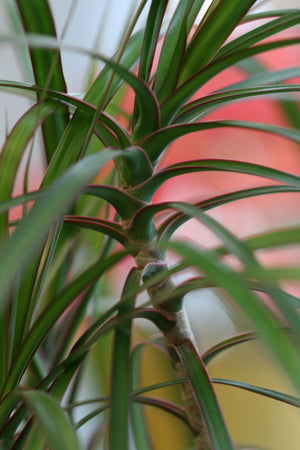
CARE
Dracaena is a forgiving and low-maintenance plant, making it ideal for both beginners and seasoned indoor gardeners. With proper care, it can thrive for years:
- Watering: Water when the top inch of soil feels dry. Avoid overwatering; Dracaena is sensitive to fluoride and chlorine, so use filtered or distilled water if possible.
- Humidity: Prefers moderate humidity but tolerates average indoor conditions. Mist occasionally or place near a humidifier in dry climates.
- Fertilizing: Feed monthly during the growing season (spring and summer) with a balanced houseplant fertilizer diluted to half strength.
- Pruning: Remove dead or yellowing leaves as needed. Cut back tall or leggy growth to encourage branching.
- Cleaning: Wipe leaves with a damp cloth to remove dust and improve photosynthesis.
- Repotting: Repot every 2–3 years or when rootbound. Use fresh soil and a slightly larger pot.
- Pests: Generally pest-resistant but may occasionally attract spider mites, scale, or mealybugs. Treat with insecticidal soap or neem oil.
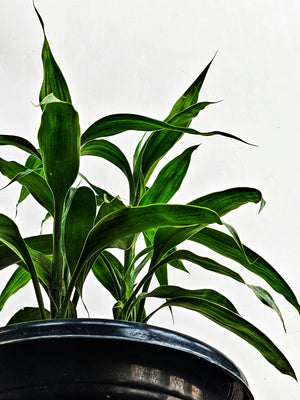
HOW TO USE
Dracaena is a versatile houseplant with bold presence. Use it to bring greenery, height, and texture into various interior design settings:
- Statement Plant: Place tall varieties like Dracaena marginata or 'Cintho' in floor pots as vertical accents in living rooms, foyers, or offices.
- Desk or Tabletop: Compact varieties like 'Tornado' and 'Michiko' work well on desks or counters where space is limited.
- Grouped Displays: Combine multiple Dracaena cultivars for varied textures and colors in a single space.
- Container Gardens: Dracaena makes an excellent anchor plant in indoor tropical arrangements with pothos, philodendron, or peace lily.
Dracaena pairs beautifully with other tropical houseplants such as ZZ plant, snake plant (Sansevieria), monstera, and bird of paradise for a rich, layered jungle aesthetic.

COMMON QUESTIONS
- Is a corn plant (Dracaena) a monocot or dicot? Dracaena is a monocot, with parallel-veined leaves and fibrous roots.
- Are Dracaena toxic to cats? Yes, Dracaena is toxic to cats if ingested, causing vomiting, drooling, and lethargy.
- How to care for Dracaena? Provide bright, indirect light, water when soil is dry, avoid harsh chemicals in water, and clean the leaves regularly.
- How to propagate Dracaena? Propagate by stem cuttings—cut a cane into sections, allow to callus, then root in water or moist soil.
- Is Dracaena toxic to dogs? Yes, it can cause similar symptoms in dogs as it does in cats if ingested.
- Should I cut brown spots off Dracaena leaves? Yes, trim away brown or yellow leaf tips with sterile scissors. Brown spots often result from dry air, fluoride, or overwatering.
- How to prune Dracaena? Cut back leggy stems just above a node to encourage branching. Always use clean, sharp tools.
Conclusion
Dracaena is a bold, elegant houseplant that offers beauty, adaptability, and ease of care. With options ranging from the bright 'Lemon Surprise' to the classic marginata, there’s a Dracaena for every indoor space. Whether you’re creating a minimalist, modern interior or a lush indoor jungle, this hardy plant will bring lasting color and sculptural interest to your home or workspace.
The Dracaena Collection
Sold Out
Sold Out
Sold Out
Sold Out
Sold Out


